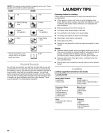
Load clothes loosely into the dryer. Do not pack the dryer. Allow
space for clothes to tumble freely. The following chart shows
examples of balanced loads that would allow for proper tumbling.
Heavy work 2 pair pants, 3 work shirts
clothes
Belicates 1 camisole, 2 slips, 4 undergarments,
1 set of sleepwear, 1 half slip
Towels 9 bath towels or 6 bath towels, 3 hand
towels, 6 wash cloths
Mixed Load 2 pillowcases, 1 T-shirt, 2 shirts,
1 pair pants
Knits 2 slacks, 2 shirts; or 3 dresses
Perm. Press 6 shirts; or 2 double sheets & 2 pillowcases;
or 2 single sheets & 2 pillowcases
Select the correct cycle and temperature for your load.
Drying tips
• Follow care label directions when they are available.
• If you use fabric softener sheets, use only ones labeled as
dryer safe. Follow package instructions.
• Remove the load from the dryer as soon as tumbling stops to
reduce wrinkling. This is especially important for permanent
press, knits, and synthetic fabrics.
Cycle and temperature tips
• Dry most loads using the Normal Dry setting (*).
• Use a More Dry setting for drying heavyweight items such as
towels and work clothes.
• Use a Normal Dry setting for drying medium weight items,
such as sheets, underwear, permanent press fabrics, and
some knits.
Use a Less Dry setting for drying lightweight items such as
lingerie, blouses, dresses, and some knits.
Use a no heat (air) setting for rubber, plastic or heat sensitive
fabrics.
• Line dry bonded or laminated fabrics.
If you are unsure of the temperature to select for a load, select a
lower setting rather than a higher setting.
NOTE: If you have questions about drying temperatures for
various loads, refer to the care label directions.
AUTO DRY II NORMALDRY
LESS DRY
_F
_0_ 110
AIR DRY 1 leo
_F
TOUCH UP _ TIMED DRY
Auto Dry II
Use this cycle to dry most loads. Dryness is determined by
thermostats that react to the amount of moisture in the air
exhausted from the dryer. Moist air indicates clothes are damp.
Dry air indicates that moisture has been removed.
This cycle includes a 10 minute (approximately) cool down period
at the end of the cycle to make clothes easier to handle and
reduce wrinkling.
Dry most loads using the Normal Dry (*) setting. When the cycle
ends, check the dryness of the load.
• If the load is drier than you like, select a setting closer to
LESS DRY the next time you dry a similar load.
• If the load is not as dry as you like, complete drying using the
Timed Dry cycle. The next time you dry a similar load, select a
setting closer to MORE DRY.
NOTE: Drying time with an automatic cycle varies according to
the type of fabric, size of load, and temperature setting. See
"Drying, Cycle and Temperature Tips."
Timed Dry
Use this cycle to complete drying if items are still damp after the
Auto Dry II cycle. Timed Dry is also useful for heavyweight and
bulky items, such as bedspreads, work clothes, and large loads
that require a long drying time. Use this cycle to get up to 110
minutes of heated drying time. The heating cycle is followed by a
10 minute (approximately) cool down period.
Touch Up
Use this cycle to smooth synthetic and permanent press clothes
that are clean but wrinkled from being crowded in a closet or
suitcase. This setting provides approximately 10 minutes of
heated tumbling followed by a 10 minute (approximately) cool
down period. Remove clothes immediately when tumbling stops.
22


















